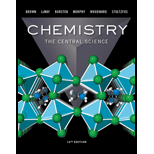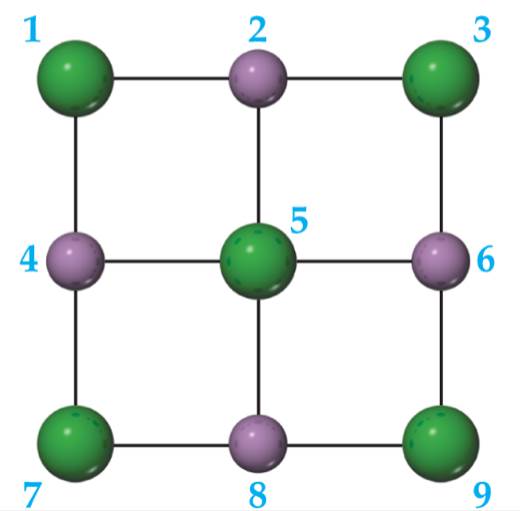
Laboratory Experiments for Chemistry: The Central Science (14th Edition)
14th Edition
ISBN: 9780134566207
Author: Theodore E. Brown, H. Eugene LeMay, Bruce E. Bursten, Catherine Murphy, Patrick Woodward, Matthew E. Stoltzfus, John H. Nelson, Kenneth C. Kemp
Publisher: PEARSON
expand_more
expand_more
format_list_bulleted
Concept explainers
Textbook Question
Chapter 8, Problem 3E
A portion of a two-dimensional "slab" of NaCl(s) is shown here (see Figure 8.2) in which the ions are numbered.
- Which colored balls must represent sodium ions?
- Which colored balls must represent chloride ions?
- Consider ion 5. How many attractive electrostatic interactions are shown for it?
- Consider ion 5. How many repulsive interactions are shown for it?
- Is the sum of the attractive interactions in part (c) larger or smaller than the sum of the repulsive interactions in part (d)?
- If this pattern of ions was extended indefinitely in two dimensions, would the lattice energy be positive or negative? [Section 8.2]

Expert Solution & Answer
Want to see the full answer?
Check out a sample textbook solution
Students have asked these similar questions
in the scope of the SCH4U course! please show all steps as im still learning how to format my answers in the format given, thank you!
help me solve this HW
Molecules of the form AH2 can exist in two potential geometries: linear or bent. Construct molecular orbital diagrams for linear and bent CH2. Identify the relevant point group, include all of the appropriate symmetry labels and pictures, and fill in the electrons. Which geometry would you predict to be more stable, and why? (Please draw out the diagram and explain)
Chapter 8 Solutions
Laboratory Experiments for Chemistry: The Central Science (14th Edition)
Ch. 8.2 - Which of the these elements is most likely to from...Ch. 8.2 - Prob. 8.1.2PECh. 8.2 - Which of the following bond is the most polar? H-F...Ch. 8.2 - Prob. 8.2.2PECh. 8.3 - Prob. 8.3.1PECh. 8.3 - Prob. 8.3.2PECh. 8.4 - Which of the following bonds is the most polar? a....Ch. 8.4 - Which of the following bonds is most polar: S-Cl,...Ch. 8.4 - Prob. 8.5.1PECh. 8.4 - The dipole moment of chlorine monofluoride,...
Ch. 8.5 - Which of the these molecules has a Lewis structure...Ch. 8.5 -
How many valence electrons should appear in the...Ch. 8.5 - Compare the lewis symbol for neon the structure...Ch. 8.5 - Prob. 8.7.2PECh. 8.5 - Prob. 8.8.1PECh. 8.5 - Prob. 8.8.2PECh. 8.5 - Prob. 8.9.1PECh. 8.5 - Prob. 8.9.2PECh. 8.6 - Which of the statements about resonance is true?...Ch. 8.6 - Prob. 8.10.2PECh. 8.7 - Prob. 8.11.1PECh. 8.7 - Prob. 8.11.2PECh. 8 - Prob. 1DECh. 8 - Prob. 1ECh. 8 - Prob. 2ECh. 8 - A portion of a two-dimensional "slab" of NaCl(s)...Ch. 8 - Prob. 4ECh. 8 - Prob. 5ECh. 8 - Incomplete Lewis structures for the nitrous acid...Ch. 8 - Prob. 7ECh. 8 - Prob. 8ECh. 8 - Prob. 9ECh. 8 - True or false: The hydrogen atom is most stable...Ch. 8 - Consider the element silicon, Si. Write its...Ch. 8 - Write the electron configuration for the element...Ch. 8 - Prob. 13ECh. 8 - What is the Lewis symbol for each of the following...Ch. 8 - Using Lewis symbols, diagram the reaction between...Ch. 8 - Use Lewis symbols to represent the reaction that...Ch. 8 - Predict the chemical formula of the ionic compound...Ch. 8 - Prob. 18ECh. 8 - Prob. 19ECh. 8 - Prob. 20ECh. 8 - Is lattice energy usually endothermic or...Ch. 8 - NaCI and KF have the same crystal structure. The...Ch. 8 - Prob. 23ECh. 8 - Prob. 24ECh. 8 - Consider the ionic compounds KF, NaCl, NaBr, and...Ch. 8 - Which of the following trends in lattice energy is...Ch. 8 - Energy is required to remove two electrons from Ca...Ch. 8 - Prob. 28ECh. 8 - Use data from Appendix C, Figure 7.10, and Figure...Ch. 8 - Prob. 30ECh. 8 - Prob. 31ECh. 8 - Prob. 32ECh. 8 - Using Lewis symbols and Lewis structures, diagram...Ch. 8 - Use Lewis symbols and Lewis structures to diagram...Ch. 8 - Prob. 35ECh. 8 - Prob. 36ECh. 8 - Prob. 37ECh. 8 - What is the trend in electronegativity going from...Ch. 8 - Prob. 39ECh. 8 - By referring only to the periodic table, select...Ch. 8 - which of the following bonds are polar? B-F,...Ch. 8 - Arrange the bonds in each of the following sets in...Ch. 8 - Prob. 43ECh. 8 - Prob. 44ECh. 8 - In the following pairs of binary compounds,...Ch. 8 - Prob. 46ECh. 8 - Prob. 47ECh. 8 - Write Lewis structures for the following: H2CO...Ch. 8 - Prob. 49ECh. 8 - Draw the dominant Lewis structure for the...Ch. 8 - Write Lewis structures that obey the octet rule...Ch. 8 - Prob. 52ECh. 8 - Prob. 53ECh. 8 - Prob. 54ECh. 8 - Prob. 55ECh. 8 - Prob. 56ECh. 8 - Prob. 57ECh. 8 - Prob. 58ECh. 8 - Prob. 59ECh. 8 - Prob. 60ECh. 8 - Prob. 61ECh. 8 - 8.62 For Group 3A-7A elements in the third row of...Ch. 8 - Draw the Lewis structures for each of the...Ch. 8 - Prob. 64ECh. 8 - In the vapor phase, BeCl2exists as a discrete...Ch. 8 -
8.66
Describe the molecule xenon trioxide, XeO3,...Ch. 8 -
8.67 There are many Lewis structures you could...Ch. 8 - Prob. 68ECh. 8 - Using Table 8.3, estimate H for each of the...Ch. 8 - Using Table 8.3, estimate H for the following...Ch. 8 - State whether each of these statements is true or...Ch. 8 - Prob. 72ECh. 8 - Prob. 73ECh. 8 - Prob. 74ECh. 8 - Prob. 75ECh. 8 - Prob. 76ECh. 8 - A new compound is made that has a C-C bond length...Ch. 8 - A new compound is made that has an N-N bond length...Ch. 8 - Prob. 79AECh. 8 - Prob. 80AECh. 8 - An ionic substance of formula MX has a lattice...Ch. 8 - Prob. 82AECh. 8 - Prob. 83AECh. 8 - Prob. 84AECh. 8 - Consider the collection of nonmetallic elements 0,...Ch. 8 - The substance chlorine monoxide, CIO(g), is...Ch. 8 -
[8.87]
a. using the electronegativities of Br...Ch. 8 - Prob. 88AECh. 8 - Although I3- is a known ion, F3- is not. a. Draw...Ch. 8 - Calculate the formal charge on the indicated atom...Ch. 8 - The hypochlorite ion, CIO- , is the active...Ch. 8 - Prob. 92AECh. 8 - a. Triazine, C3 H3N3, is like benzene except that...Ch. 8 - Prob. 94IECh. 8 - Prob. 95IECh. 8 - Prob. 96IECh. 8 - Prob. 97IECh. 8 - Prob. 98IECh. 8 - Prob. 99IECh. 8 - Prob. 100IECh. 8 - Prob. 101IECh. 8 - Prob. 102IECh. 8 -
8.103 The compound chloral hydrate, known in...Ch. 8 - Barium azide is 62.04% Ba and 37.96% N. Each azide...Ch. 8 - Acetylene (C2H2) and nitrogen (N2) both contain a...Ch. 8 - Prob. 106IECh. 8 - Prob. 107IECh. 8 -
8.108 Formic acid has the chemical formula...Ch. 8 - Prob. 109IECh. 8 - Prob. 110IE
Knowledge Booster
Learn more about
Need a deep-dive on the concept behind this application? Look no further. Learn more about this topic, chemistry and related others by exploring similar questions and additional content below.Similar questions
- Indicate the variation in conductivity with concentration in solutions of strong electrolytes and weak electrolytes.arrow_forwardThe molar conductivity of a very dilute solution of NaCl has been determined. If it is diluted to one-fourth of the initial concentration, qualitatively explain how the molar conductivity of the new solution will compare with the first.arrow_forwardWhat does the phrase mean, if instead of 1 Faraday of electricity, Q coulombs (Q/F Faradays) pass through?arrow_forward
- What characteristics should an interface that forms an electrode have?arrow_forwardFor a weak acid AcH, calculate the dissociated fraction (alpha), if its concentration is 1.540 mol L-1 and the concentration [H+] is 5.01x10-4 mol L-1.arrow_forwardIf the molar conductivity at infinite dilution of HAC is A0 = 390.5 S cm² mol¹. Calculate the Arrhenius conductivity of a 9.3% by weight solution of HAc with a pH of 3.3. Data: molecular weight of HAC is 60.05 g/mol and the density of the solution is 1 g/cm³.arrow_forward
- If the molar conductivity at infinite dilution of HAC is A0 = 390.5 S cm² mol¹. Calculate the Arrhenius conductivity of a 9.3% by weight solution of HAc with a pH of 3.3. Data: molecular weight of HAC is 60.05 g/mol and the density of the solution is 1 g/cm³.arrow_forwardIf the molar conductivity at infinite dilution of HAC is A0 = 390.5 S cm² mol¹. Calculate the Arrhenius conductivity of a 9.3% by weight solution of HAc with a pH of 3.3. Data: molecular weight of HAC is 60.05 g/mol and the density of the solution is 1 g/cm³.arrow_forwardDetermine the distance between the metal and the OHP layer using the Helm- holtz model when the electrode's differential capacitance is 145 μF cm². DATA: dielectric constant of the medium for the interfacial zone &r= lectric constant of the vacuum &0 = 8.85-10-12 F m-1 = 50, die-arrow_forward
- Describe a sequence of photophysical processes that can be followed by radiation adsorbed by a molecule in the ground state to give rise to phosphorescent emission.arrow_forwardState two similarities between fluorescence and phosphorescence.arrow_forwardState three photophysical processes that can be related to the effects of incident radiation on a molecule in its ground state. Consider that radiation can give rise to fluorescent emission, but not phosphorescent emission.arrow_forward
arrow_back_ios
SEE MORE QUESTIONS
arrow_forward_ios
Recommended textbooks for you
 Chemistry by OpenStax (2015-05-04)ChemistryISBN:9781938168390Author:Klaus Theopold, Richard H Langley, Paul Flowers, William R. Robinson, Mark BlaserPublisher:OpenStax
Chemistry by OpenStax (2015-05-04)ChemistryISBN:9781938168390Author:Klaus Theopold, Richard H Langley, Paul Flowers, William R. Robinson, Mark BlaserPublisher:OpenStax Chemistry: Principles and PracticeChemistryISBN:9780534420123Author:Daniel L. Reger, Scott R. Goode, David W. Ball, Edward MercerPublisher:Cengage Learning
Chemistry: Principles and PracticeChemistryISBN:9780534420123Author:Daniel L. Reger, Scott R. Goode, David W. Ball, Edward MercerPublisher:Cengage Learning Introductory Chemistry: A FoundationChemistryISBN:9781337399425Author:Steven S. Zumdahl, Donald J. DeCostePublisher:Cengage Learning
Introductory Chemistry: A FoundationChemistryISBN:9781337399425Author:Steven S. Zumdahl, Donald J. DeCostePublisher:Cengage Learning Chemistry for Engineering StudentsChemistryISBN:9781337398909Author:Lawrence S. Brown, Tom HolmePublisher:Cengage Learning
Chemistry for Engineering StudentsChemistryISBN:9781337398909Author:Lawrence S. Brown, Tom HolmePublisher:Cengage Learning Chemistry: The Molecular ScienceChemistryISBN:9781285199047Author:John W. Moore, Conrad L. StanitskiPublisher:Cengage Learning
Chemistry: The Molecular ScienceChemistryISBN:9781285199047Author:John W. Moore, Conrad L. StanitskiPublisher:Cengage Learning

Chemistry by OpenStax (2015-05-04)
Chemistry
ISBN:9781938168390
Author:Klaus Theopold, Richard H Langley, Paul Flowers, William R. Robinson, Mark Blaser
Publisher:OpenStax

Chemistry: Principles and Practice
Chemistry
ISBN:9780534420123
Author:Daniel L. Reger, Scott R. Goode, David W. Ball, Edward Mercer
Publisher:Cengage Learning

Introductory Chemistry: A Foundation
Chemistry
ISBN:9781337399425
Author:Steven S. Zumdahl, Donald J. DeCoste
Publisher:Cengage Learning

Chemistry for Engineering Students
Chemistry
ISBN:9781337398909
Author:Lawrence S. Brown, Tom Holme
Publisher:Cengage Learning

Chemistry: The Molecular Science
Chemistry
ISBN:9781285199047
Author:John W. Moore, Conrad L. Stanitski
Publisher:Cengage Learning

Types of bonds; Author: Edspira;https://www.youtube.com/watch?v=Jj0V01Arebk;License: Standard YouTube License, CC-BY